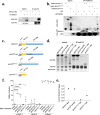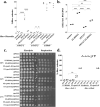Decreasing mitochondrial RNA polymerase activity reverses biased inheritance of hypersuppressive mtDNA
- PMID: 34665800
- PMCID: PMC8555793
- DOI: 10.1371/journal.pgen.1009808
Decreasing mitochondrial RNA polymerase activity reverses biased inheritance of hypersuppressive mtDNA
Abstract
Faithful inheritance of mitochondrial DNA (mtDNA) is crucial for cellular respiration/oxidative phosphorylation and mitochondrial membrane potential. However, how mtDNA is transmitted to progeny is not fully understood. We utilized hypersuppressive mtDNA, a class of respiratory deficient Saccharomyces cerevisiae mtDNA that is preferentially inherited over wild-type mtDNA (rho+), to uncover the factors governing mtDNA inheritance. We found that some regions of rho+ mtDNA persisted while others were lost after a specific hypersuppressive takeover indicating that hypersuppressive preferential inheritance may partially be due to active destruction of rho+ mtDNA. From a multicopy suppression screen, we found that overexpression of putative mitochondrial RNA exonuclease PET127 reduced biased inheritance of a subset of hypersuppressive genomes. This suppression required PET127 binding to the mitochondrial RNA polymerase RPO41 but not PET127 exonuclease activity. A temperature-sensitive allele of RPO41 improved rho+ mtDNA inheritance over a specific hypersuppressive mtDNA at semi-permissive temperatures revealing a previously unknown role for rho+ transcription in promoting hypersuppressive mtDNA inheritance.
Conflict of interest statement
The authors have declared that no competing interests exist. Author Angelika Amon was unable to confirm their authorship contributions. On their behalf, the corresponding author has reported their contributions to the best of their knowledge.
Figures





References
-
- Veatch JR, McMurray M a, Nelson, Gottschling DE. Mitochondrial dysfunction leads to nuclear genome instability via an iron-sulfur cluster defect. Cell [Internet]. 2009. Jun 26 [cited 2014 Aug 7];137(7):1247–58. Available from: http://www.pubmedcentral.nih.gov/articlerender.fcgi?artid=2759275&tool=p... doi: 10.1016/j.cell.2009.04.014 - DOI - PMC - PubMed
Publication types
MeSH terms
Substances
Associated data
Grants and funding
LinkOut - more resources
Full Text Sources
Molecular Biology Databases

